Boeing 727-225
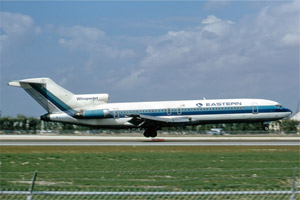
Photo copyright Bob Garrard - used with permission
Eastern Airlines Flight 66, N8845E
Jamaica, New York
June 24, 1975
On June 24, 1975, at 1605 Eastern Daylight Time (EDT), Eastern Airlines Flight 66, a Boeing 727, approaching to land at New York's John F. Kennedy International Airport runway 22L, encountered adverse winds and heavy rain associated with a strong thunderstorm. The winds resulted in a high descent rate, and the aircraft impacted the approach light towers short of the intended runway. The aircraft caught fire and came to rest on a highway, just north of the runway threshold. The impact sequence and resultant fire destroyed the aircraft. Of the 124 persons aboard, 113 passengers and crewmembers died in the crash.
This accident highlighted the inadequacies of terminal area weather analysis related to the recognition and reporting of severe weather information. It also highlighted the need for flight crews to recognize and avoid low-altitude hazards associated with thunderstorms along or near the approach path. It further emphasized the need for air traffic control to refine standard operating procedures to respond to severe weather in and around the terminal area. Meteorological analysis of this accident led to the discovery of severe downdraft phenomena associated with convective systems, and the term “downburst” was developed. This accident became the catalyst for further research which led to the definition of a specific danger to aviation known as a “microburst,” which is a concentrated downburst that affects an area 4 km (2.5 mi) in diameter, or less, and can generate winds in excess of 160 mph. Following the accident, subsequent research resulted in the development and deployment of the Low Level Windshear Alert System (LLWAS) at over 100 airports over the next decade.
History of Flight
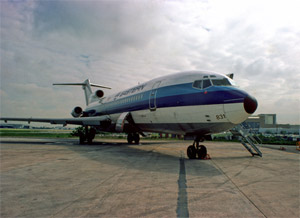
Photo copyright Kenny Ganz - used with permission
Eastern Airlines Flight 66 was a regularly scheduled passenger flight between New Orleans, Louisiana and New York's John F. Kennedy International Airport (JFK), Jamaica, New York. The flight, a Boeing 727 with 116 passengers and a crew of 8 aboard departed New Orleans at 1319 Eastern Daylight Time (EDT) with a planned arrival around 1600. The National Weather Service (NWS) forecast for JFK called for thunderstorms and rain showers after 1800. The forecast was amended at 1430 to include thunderstorms and moderate rain showers after 1515. At 1545, the forecast was further amended to call for thunderstorms, heavy rain showers with visibilities as low as ½ mile, and winds from 270 degrees at 30 knots with gusts to 50 knots after 1615. However, there is no evidence that the flight crew of Eastern 66 received any of these forecasts.
The Eastern Air Lines weather forecast, which was issued at 1208, and was valid from 1215 to 2000, predicted widely scattered thunderstorms with tops from 30,000 to 40,000 feet in New York and eastern New Jersey. The terminal forecast for New York City predicted scattered clouds until 2000; thereafter, thunderstorms were possible with light rain showers. The flight crew of Eastern 66 received this forecast before departing New Orleans. LaGuardia airport, near to JFK was filed as the flight's alternate destination.
A significant feature of the weather at JFK on the day of the accident was the presence of a stationary sea-breeze front which held for over an hour near the approach end of runway 22L. This front did not effect the growth of the thunderstorms that were in the area, which were already violent, but was significant in that the airport wind sensor used by air traffic control was located near the opposite end of the runway (almost 15,000 feet away from the thunderstorm) and was influenced by the onshore sea-breeze. It therefore gave information that called for landings to the southwest on runway 22L. However, just to the north, at the approach end of runway 22L, high winds were beginning to occur as a result of the rapidly deteriorating weather. Due to the localized nature of the downbursts that were occurring, the airport wind sensor did not detect the high winds associated with the weather that caused the accident.
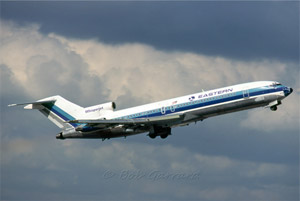
Photo copyright Bob Garrard - used with permission
The flight was uneventful until arriving in the New York City terminal area. Beginning at 1535 EDT, Kennedy approach control (Southgate arrival controller) provided radar vectors to sequence the flight with other traffic, and to position the aircraft for an ILS approach to runway 22L. The flight had received the Automated Terminal Information Service (ATIS) which stated: "Kennedy weather, VFR, sky partially obscured, estimated ceiling 4,000 broken. 5 miles with haze… …wind 210 degrees at 10, altimeter 30.15. Expect vectors to an ILS runway 22L, landing runway 22L, departures are off 22R..." Traffic concentration into JFK was high, with aircraft landing on runway 22L every 1-2 minutes.
As Eastern 66 approached the Long Island area from the south, a violent thunderstorm was starting to affect landing traffic at JFK. For 4 minutes, between 1544 and 1548, a strong downdraft, which is now understood to be the first downburst cell at the approach end of the arrival runway, caused three aircraft to experience slight difficulties in landing related to wind shear, heavy rain and deviations below the glideslope. Departures were unaffected and no mention of the severe weather was broadcast to arriving traffic. Subsequent landings were accomplished with no difficulty.
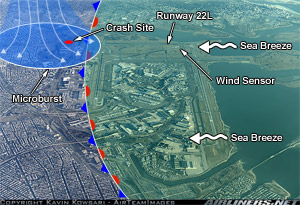
Photo copyright Kavin Kowsari - Air Team Images - used with permission
View Larger
The flight was uneventful until arriving in the New York City terminal area. Beginning at 1535 EDT, Kennedy approach control (Southgate arrival controller) provided radar vectors to sequence the flight with other traffic, and to position the aircraft for an ILS approach to runway 22L. The flight had received the Automated Terminal Information Service (ATIS) which stated: "Kennedy weather, VFR, sky partially obscured, estimated ceiling 4,000 broken. 5 miles with haze… …wind 210 degrees at 10, altimeter 30.15. Expect vectors to an ILS runway 22L, landing runway 22L, departures are off 22R..." Traffic concentration into JFK was high, with aircraft landing on runway 22L every 1-2 minutes.
As Eastern 66 approached the Long Island area from the south, a violent thunderstorm was starting to affect landing traffic at JFK. For 4 minutes, between 1544 and 1548, a strong downdraft, which is now understood to be the first downburst cell at the approach end of the arrival runway, caused three aircraft to experience slight difficulties in landing related to wind shear, heavy rain and deviations below the glideslope. Departures were unaffected and no mention of the severe weather was broadcast to arriving traffic. Subsequent landings were accomplished with no difficulty.
At 1552, the Southgate arrival controller broadcast that the field was VFR with a 5-mile visibility, light, very light rain shower and haze. Within a minute this broadcast was updated with the information that the field had just gone IFR with 2 miles visibility, very light rain showers and haze. Control transmitted; "…the runway visual range is---not available, and Eastern 66 descend and maintain four thousand, Kennedy radar one three two four." Eastern 66 acknowledged the transmission.
Eastern 66 was one of a number of aircraft that were being vectored to intercept the ILS localizer course for runway 22L. At 1553, the flight contacted the Kennedy final vector controller who continued to provide radar vectors around thunderstorms in the area, sequencing the flight with other traffic, and positioning the flight on the localizer course.
Between 1552 and 1600 a second, more severe, downburst affected arriving traffic. A 747, which landed at 1552, experienced some wind shear, but, according to the accident report, did not warrant reporting. This aircraft was followed by a 707, which landed at 1554, and experienced a drift to the left at 200 feet which required ~8 degrees of heading change to correct. After this, two aircraft experienced major difficulties.
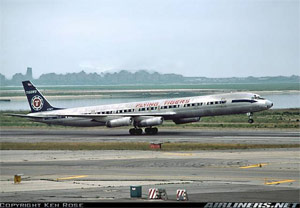
Photo copyright Ken Rose - used with permission
Flying Tiger Flight 161, a DC-8, flew into heavy rain at 1000 feet and then experienced a strong downdraft, severe changes of wind direction, turbulence, airspeed fluctuations of 15 to 30 knots, and a strong crosswind which pushed the airplane to the left. The captain had to apply 25 to 30 degrees of heading change to correct this deviation. At 300 feet, this pilot applied almost maximum thrust to arrest the descent and to maintain approach speed. The aircraft touched down at approximately 1556. Flight 161 reported problems to the local controller after clearing the runway landing at 1557:30; "I just highly recommend that you change the runways and land northwest, you have such a tremendous wind shear down near the ground on final." To which the local controller responded; "Okay, we're indicating wind right down the runway at 15 knots when you landed." The captain of Flight 161 retorted; "I don't care what you're indicating; I'm just telling you that there's such a wind shear on the final on that runway you should change it to the northwest." In post-accident interviews, the Flying Tiger captain stated he believed that the conditions were so severe that he would not have been able to abandon the approach after he had applied maximum thrust and therefore he landed. Post-accident analysis of the DC-8's drift to the left indicated that, in addition to the downdraft, the aircraft experienced a 60-70 knot crosswind close to the ground.
Eastern 902, an L-1011, abandoned its approach at 1558 after experiencing major difficulties. This flight flew into heavy rain at 400 feet, experienced a rapid drop in airspeed from 150 knots indicated to 120 knots, and the rate of descent increased significantly. Unlike the preceding Flying Tiger flight, this aircraft moved to the right of the localizer course and the captain elected to abandon the approach. He was unable to arrest the aircraft's descent until he had established a high nose up attitude and had applied near maximum thrust. He thought the aircraft had descended to about 100 feet before it began to climb. Post-accident analysis showed that Eastern 902, despite applying power at 250 feet, did not start recovering altitude until it was just 60 feet above the ground.
At 1557:55, the local controller transmitted missed approach directions to Eastern 902 and asked "…was wind a problem?" Eastern 902 answered, "Affirmative."
Finnair 105, a DC-8 then landed normally without difficulties at 1559.
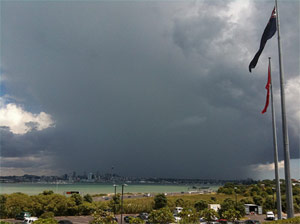
Around 1557, while Eastern 902 was on approach, the Eastern 66 flight crew discussed problems associated with carrying minimum fuel loads when confronted with delays in terminal areas. One of the crewmembers stated that he was going to check weather at the alternate airport, which was essentially "next door" at LaGuardia airport, and affected by the same weather patterns. Less than a minute later one of the crewmembers remarked, "…one more hour and we'd come down whether we wanted to or not."
At 1559, the final vector controller transmitted a message to all aircraft on his frequency that "a severe wind shift" had been reported on the final approach to runway 22L, and that he would report more information shortly.
At 1559:40, Eastern 902 re-established radio communications with the JFK final vector controller and reported; "…we had… a pretty good shear pulling us to the right and… down and visibility was nil, nil out over the marker.. .correction.. at 200 feet it was.. .nothing.". The final vector controller responded; "Okay, the shear you say pulled you right and down?". Eastern 902 replied; "Yeah, we were on course and down to about 250 feet. The airspeed dropped to about 10 knots below the bug and our rate of descent was up to 1,500 feet a minute, so we put takeoff power on and we went around at a hundred feet."
When queried by control if Eastern 66 had heard Eastern 902's report. Eastern 66 replied, "…affirmative,"…
At this point the controller established Flight 66's position as being 5 miles from the outer marker and cleared the flight for an ILS approach to runway 22L. Eastern acknowledged the clearance just prior to 1601 with the statement; "Okay, we'll let you know about the conditions?"
The first officer, who was flying the aircraft, called for completion of the final checklist and while completing this checklist the captain stated that the radar was, "Up and off… .standby."
At 1602:20 the captain said, "…I have the radar on standby in case I need it, I can get it off later." indicating that the flight crew anticipated a go-around as a possibility.
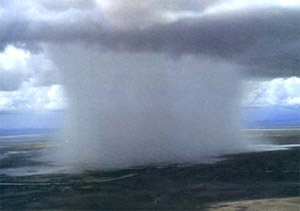
At 1602:42, the final vector controller asked Eastern 902; "..would you classify that as a severe wind shift, correction, shear?" The flight responded; "Affirmative."
At 1602:50, the first officer of Eastern 66 said; "Gonna keep a pretty healthy margin on this one." An unidentified crewmember said; "I… would suggest that you do." The first officer responded; "In case he's right."
Eastern reported over the outer marker and the flight was cleared to contact Kennedy tower. The Kennedy tower controller cleared Eastern 66 to land. The captain acknowledged the clearance and asked; "Got any reports on braking action…?" The local controller did not respond until the query was repeated. At 1604:14, the local controller replied; "No, none, approach end of runway is wet.. .but I'd say about the first half is wet – we've had no adverse reports."
His query and the comment to "…keep a pretty healthy margin…" by the Eastern flight crew appears to be in line with the, then current, Eastern Airlines Administrative Bulletins on low-level wind shear associated with both thunderstorms and frontal-zone weather. The bulletins implied that higher approach speeds should be used when shear is anticipated, but cautioned that when runways are wet excessive landing speeds should be avoided because of hydroplaning.
Accident Sequence
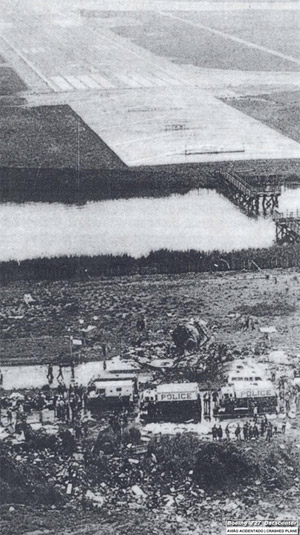
Eastern 66 continued the approach into what is now known to be a classic downburst/microburst encounter. The flight initially experienced this downburst as light rain while centered on the glideslope with airspeed oscillating between 140 and 145 knots. At approximately 500 feet, Flight 66 experienced heavy rain and an increasing headwind "shear" with gusts of 10-20 knots, which resulted in a deviation above glideslope. The resultant pilot reaction was to retard throttles to re-stabilize the approach speed and a relaxation of pitch to re-acquire glideslope. Around this time, the aircraft transited the initial outflow front and then experienced the center of the microburst which yielded a severe downdraft with vertical winds of 1000-1500 feet per minute and a cessation of the previous headwind, leaving the aircraft in a low energy state and with a large downward inertia. Flight 66 descended rapidly below the glideslope with a descent rate of approximately 1500 fpm, and the airspeed decreased from 138 knots to 123 knots in 2.5 seconds. When the aircraft was at 150 feet, the captain called "runway in sight." The first officer, who was flying the aircraft, acknowledged the runway about a second later. Three seconds later, the first officer called for takeoff thrust, but the aircraft impacted the "non-frangible" approach lights approximately 2300 feet short of the runway threshold, caught fire and disintegrated. The wreckage ultimately came to rest on Rockaway Boulevard located north of runway 22L.
In the course of the investigation, airline crews were interviewed on their decision-making process with regard to ascertaining whether an approach was hazardous. Crews reported that when they conducted instrument approaches to airports affected by weather hazards, they relied substantially on the experience of preceding flights as to whether to make the approach themselves or to choose a different course of action. Eastern 66 would not have heard the conversation between the tower controller and the Flying Tiger flight crew about their experience on landing. Approach control had only reported the Flying Tiger experience as a "severe wind shift" on final. Eastern 66 did hear the detailed report of Eastern 902's missed approach but then would have been aware that two more aircraft had landed with no reported problems.
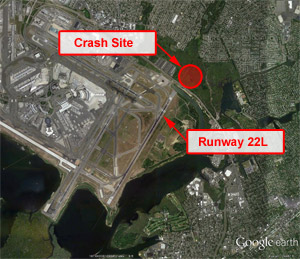
Eyewitness Accounts
The aircraft transited a severe downpour with high winds, lightning, and thunder (classic wet microburst). Witnesses located at the outer marker reported heavy rain and very high winds. Witnesses at the airport, who were just over ½ mile south of Rockaway Boulevard stated that no rain was falling at their location when they saw the crash. They further stated that the visibility to the northeast was good, but that visibility to the north was reduced. Witnesses who were located approximately 1½ miles north of Rockaway Boulevard described the weather conditions when Eastern 66 passed overhead as; Heavy rain, lightning and thunder, and the wind blowing hard from directions ranging from north through east.
An animation of the accident sequence, and the associated weather phenomena is available below:
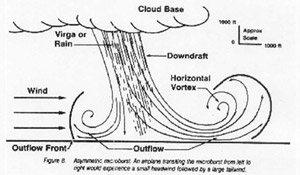
View Larger
Weather in the Vicinity of JFK Airport
The weather at JFK on the day of the Flight 66 accident was influenced by a slow moving cold front that ran from the southwest to the northeast. This front was moving into the area and was spurring the development of scattered thunderstorms in Northern Pennsylvania, New Jersey and the New York City area. In addition, for over an hour prior to the accident, a stationary "sea-breeze front" had formed near the approach end of the active runway, 22L. While this front did not influence the growth of the thunderstorms, which were already violent by the time they arrived north of JFK, it did affect the wind direction that was being reported to the tower controller. The airport wind sensor was located near the opposite end of the runway, and therefore was measuring the gentle sea breeze, which continued to show gentle winds straight down the runway, effectively masking the severity of the weather through which approaches were being flown. Based on this information, air traffic controllers continued to direct approaches from the north, through stormy weather.
Evident in the post accident analysis of the weather patterns on the day of the accident was the dramatic changes in the weather that occurred in the hour before the accident. The JFK thunderstorm, which ultimately created the family of downbursts that crossed the approach end of runway 22L, moved rapidly toward the western tip of Long Island. The cold sea-breeze front would hold back the southern outflow of the forerunner storms. In addition, the squall-line activity in eastern Pennsylvania and northern New Jersey was intensifying rapidly, resulting in a surge of northwesterly winds that fed warm air into the area north of JFK airport, creating tremendous instability just north of the approach end of the runway. This sequence of events, along with the convergence of the JFK thunderstorm with the forerunner storms, focused the energy of the storms leading to the development of the JFK downbursts.
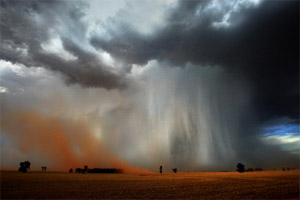
At the time of the accident, there was no SIGMET in effect for the New York City terminal area. Investigators determined that Eastern 66 had only been supplied with their company weather forecast, predicting widely scattered thunderstorms in New York and eastern New Jersey, and the terminal forecast predicting scattered clouds until 2000, with thunderstorms possible with light rain showers thereafter.
The National Weather Service Forecast Office located in midtown Manhattan did issue a strong wind warning at 1526 which was valid from 1600 to 2000, calling for gusty surface winds to 50 knots from the west in thunderstorms in the New York City terminal area. This warning was distributed to the JFK airport but there was no evidence Eastern 66 received this warning.
Investigators determined that the primary weather indicators to Eastern 66 were the preceding aircraft on the approach path. The controller was only able to report a "severe wind shift" which had been reported on final approach by a previous aircraft (the Flying Tigers DC-8), and then Eastern 66 overheard the report of Eastern 902 after flight 902 had accomplished a go-around.
Investigators concluded that there was a deficiency in the ability to discern hazardous weather conditions, and the Eastern 66 accident investigation correctly acknowledged the need for reliable windshear detection equipment at commercial airports, along with the dissemination of severe weather information to the air traffic control system.
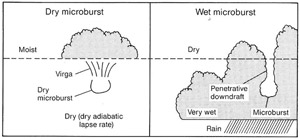
Figure from “Microbursts-A Handbook for Visual Identification” (Caracena et al, NOAA, 1989)
View Larger
The investigators identified a contributing factor as the fact that prior to Flight 66, Eastern Airlines flight crews had received advisory information on how to "cope" with windshear hazards on final approach. The technique taught was to increase the approach speed in order to provide an additional airspeed margin above the aircraft's stall speed, thereby allowing a performance capability for safe transit of the expected windshear by sacrificing airspeed for altitude if severe downdrafts or tailwinds were experienced. The main caution to the crews who were taught this technique was to check for braking conditions to ensure that this added speed did not significantly degrade the landing performance. Having obtained a report that there were no braking difficulties, the Eastern 66 flight crew decided to continue the approach, planning to execute a go-around if necessary.
Although the accident report discerned that Eastern 66 had, in fact, added 10-15 knots airspeed to the normal approach speed, the NTSB, as a result of piloted simulations accomplished using assumptions about the wind conditions on the day of the accident, was uncertain as to whether the accident could have been avoided by quicker recognition and correction of the high descent rate caused by the "adverse winds" from the thunderstorm. Transition from instruments to visual indications would likely have been difficult due to the heavy rain that the flight was penetrating on short final. It was unclear whether the downdraft that Eastern 66 encountered was too severe for a successful approach and landing even if they had relied upon, and responded rapidly to, the indications of the flight instruments.
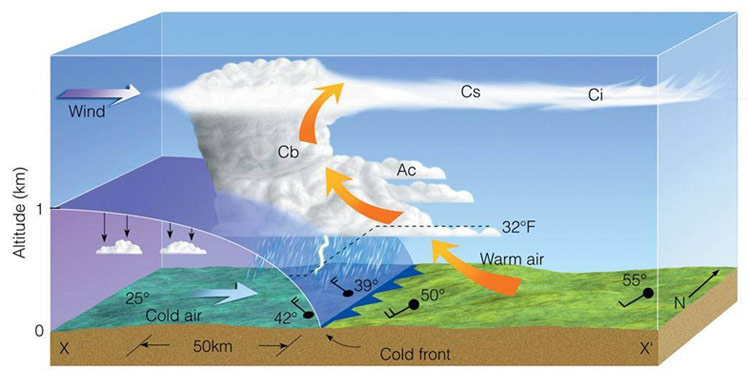
This accident became the catalyst for extensive meteorological investigation that would lead to the discovery of the downburst/microburst phenomenon.
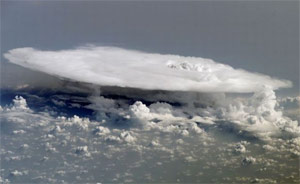
The Windshear Hazard
Low Level Windshear associated with both thunderstorms and frontal-zone weather had been identified as a flight hazard prior to Flight 66. Thunderstorms were generally understood to contain severe vertical currents, downdrafts, and outflows which could create "gust fronts.” These storms were often accompanied by heavy rain. In a generic sense, the wind conditions that are typically present with thunderstorms and convective weather fit the Windshear definition (e.g., a change in wind direction and/or speed in a very short distance in the atmosphere). At the time of this accident, the presence of thunderstorms in the vicinity of an airport, while cause for concern, did not constitute a level of hazard that would prompt air traffic control personnel to take an action to change the active runway or traffic flow unless the weather was affecting landing visibility or surface conditions at the airport itself. Air traffic control was primarily concerned with the separation of aircraft from other aircraft, as opposed to separation of aircraft from adverse weather. The National Weather Service could give general reporting and forecasting of significant weather, but at the time was not equipped with the tools that could give a reliable prediction of storm movements or hazardous winds in the terminal area.
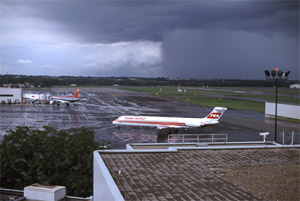
Photo copyright George Hamlin - used with permission
The characteristics of downbursts and microbursts are such that they are highly dynamic, localized, and relatively transient in nature. One or more aircraft can transit an area safely, while a following aircraft, such as Eastern 66, can encounter the severe effects of the downburst while passing through the same airspace. A following aircraft could subsequently transit the same area, and also experience no adverse effects.
A video acquired from KSHB (NBC) TV in Kansas City illustrates the rapid and transient nature of downbursts and microbursts how rapidly they can occur. As noted in the video, the rapidly descending air mass associated with a microburst can be referred to as an “atmospheric bomb,” in that it can descend suddenly through a larger air mass, and if atmospheric conditions are conducive, will descend until impacting the ground.
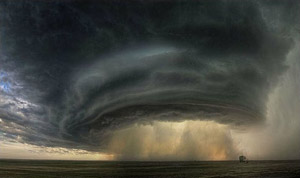
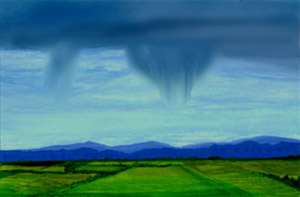
A downburst is a negatively buoyant parcel of air specified as having a downward speed of at least 12 feet per second (~20 knots) when measured at an altitude of 300 feet above the ground (which is comparable to the speed of a jet transport following the usual 3 degree glideslope on final approach). The downburst has a spatial extent of 0.8 kilometers (0.5 miles) or larger, which makes it large enough to have a noticeable effect on an aircraft (a smaller spatial extent is experienced by the aircraft as turbulence).
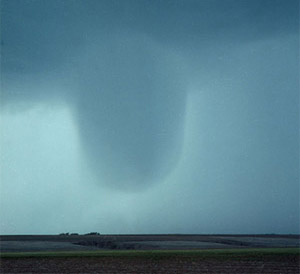
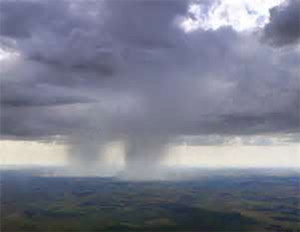
Although the term "microburst" and "downburst" are sometimes used interchangeably, the term "microburst" was actually created to specifically distinguish a hazard to aviation where the energy of the downburst is focused within a spatial extent less than 4 kilometers (2.5 miles), which is on the order of a typical jet transport runway length. Although falling precipitation can contribute to a downdraft, the primary forcing mechanism of the microburst is evaporation. There is no correlation between rain rate and microburst intensity. In a microburst, evaporation cools the air. The rain-cooled air can be significantly colder, and more dense, than its environment, creating negative buoyancy. The rate of sinking depends on the temperature difference. Several degrees of temperature differential can cause downward speeds of 35-50 knots. If there is a temperature differential between the cold parcel of air and its environment all the way to the ground, the microburst will accelerate until it hits the ground causing strong horizontal wind gusts. Microbursts can occur with and without precipitation reaching the ground and can cause damage at and around the impact point. A Video of an experiment illustrating the formation of a downburst is available below:
A high speed video of an actual microburst, the result of the processes described in the previous video, is available below. This copyrighted video was provided by Mr. Bryan Snider, a Phoenix, Arizona professional photographer, and is used here with his permission.
In the decade after Eastern 66, downburst diameters would be observed to range from as little as 0.5 mile to 10's of miles in diameter. The specific hazard to aviation continued to be extensively researched and analyzed to be related to the scale of the downburst. The smaller spatial scale of a small, intense downburst was found to result in tighter windshear gradients that are experienced by penetrating aircraft as more rapid changes in wind vectors, perhaps well in excess of the performance capabilities of the airplane. In order to identify and differentiate the various downdraft phenomena and to draw attention to the serious hazard posed to aircraft, the term microburst was later defined by Dr. Theodore Fujita of the University of Chicago describing a downburst with a diameter less than four km (2.2 nautical miles), roughly equivalent to a typical transport airplane runway length.
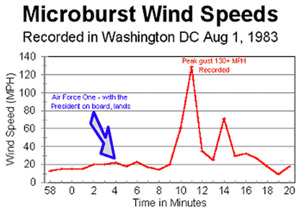
In August 1983, the strongest microburst recorded at an airport was observed at Andrews Air Force Base in Washington DC. The peak horizontal winds speeds were recorded at greater than 130 knots in this microburst. The peak gust was recorded 7 minutes after Air Force One, with U.S. President Ronald Reagan on board, landed on the same runway as the microburst was recorded.
Meteorology course lecture material can be accessed at the following links. The lecture material discusses both downburst and microburst phenomena, courtesy of Dr. Matthew Eastin of the University of North Carolina at Charlotte (Downbursts), and Dr. Haiyan Jiang of Florida International University, (Microbursts). Many of Dr. Jiang's lecture slides are extracted from the textbook Severe & Hazardous Weather-- An introduction to high impact meteorology" by Rauber et al,. and published by Kendall Hunt. Both presentations provide separate overviews of downburst and Microburst phenomena.
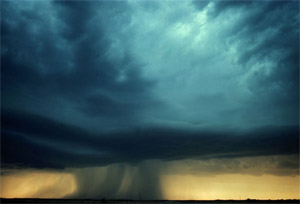
Photo of a microburst
Advances in Windshear Detection Technology
As a result of the Flight 66 accident investigation, a study was conducted to better understand the weather phenomena associated with this accident. The resulting report, "Spearhead Echo and Downburst in the Crash of an Airliner", authored by T. Theodore Fujita and Horace R. Byers would use a detailed meteorological study to discover the presence of a severe downdraft phenomenon that was not previously understood. This downdraft phenomenon would be designated as a "downburst." In this report, the downburst was described as a localized, intense downdraft with vertical currents exceeding a downward speed of 12 feet per second (approximately 720 feet per minute) at 300 feet above the surface. This value corresponded with the approximate downward speed of a typical transport aircraft flying a stabilized 3 degree glideslope, thus capable of doubling the descent rate of the affected aircraft.
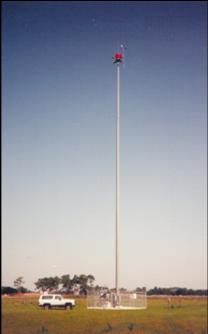
Fujita theorized that since an aircraft may fly into a downburst cell abruptly and unexpectedly, immediate recognition and quick action by the pilot would be necessary to overcome its effects. Of equal importance in this report, was the realization that the atmospheric conditions that spurred development of this phenomenon could result in a "family" of downburst cells that could affect some aircraft approaching a runway while others would remain relatively unaffected. It would be several years before the Joint Airport Weather Study (JAWS, 1982) measurements, and high profile windshear crashes in New Orleans (Pan American Flight 759, 1982) and Dallas-Fort Worth (Delta Flight 191, 1985) would lead to the acceptance of Fujita’s theories within the aviation meteorology community.
Around the same time that Dr. Fujita was completing this research, and in direct response to the Eastern 66 accident, the Federal Aviation Administration (FAA) in 1976 developed and began deployment of the Low Level Windshear Alert System (LLWAS). The initial implementation, LLWAS Phase I, was in response to the belief that the Eastern 66 accident was a result of a gust front encounter. This early form of LLWAS had only six anemometers and was designed to detect a gust front. It had no downburst/microburst detection capabilities and, due to the early alert logic, it had the potential to provide misleading information or false alerts. It was not until the analysis of anemometer data obtained from studies subsequent to the Eastern 66 accident, and several high-profile accidents, notably Delta Flight 191 in 1985, that LLWAS Phase 2 was developed and fielded which utilized an improved algorithm that provided some microburst detection capability and reduced the number of false windshear alerts.
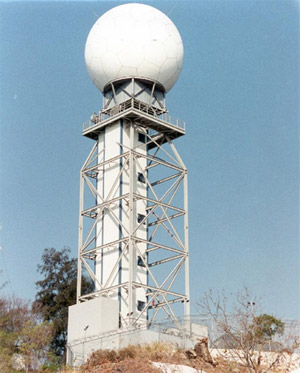
Phase 2 LLWAS was a stand-alone system which had drawbacks in that the time required to recognize and then transmit the information to interested airplanes reduced its capabilities to provide timely warnings. Today the Phase 2 LLWAS is obsolete, having been replaced by high-quality microburst detection algorithms, so-called Phase 3 LLWAS. This latest LLWAS provides detailed windshear alerts to air traffic controllers and is effective for wet- and dry- climate microbursts. Windshear is also detected with Terminal Doppler Weather Radar (TDWR) which were designed specifically for the detection of microbursts in the terminal areas of high-density airports. TDWR is highly effective when windshear is accompanied by precipitation but is not as effective in dry climates.
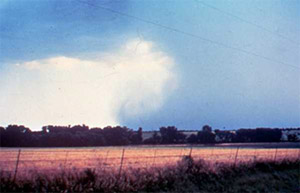
Light Detection and Ranging (LIDAR) Doppler systems, which "see" aerosols to detect windshear, are now finding their way into use. LIDAR Doppler systems are capable of detecting microbursts in dry climates. In conjunction with all these ground-based windshear detection sensors has been an effort to meld these weather systems, and others into the Integrated Terminal Weather System (ITWS) which now yields one display with consistent terminology for Air Traffic Control to report weather information including windshear alerts to arriving or departing traffic. Similarly, the information from each of these systems is used in the Windshear and Turbulence Warning System (WTWS), which makes the source of the information and alerts transparent to Air Traffic Control personnel. Windshear alerts now use a standard phraseology, providing the flight crew with Runway, Alert type (wind shift, microburst, etc.), Loss or Gain, and Location of first windshear encounter with relation to the Runway. Operators typically have specific operating procedures when certain alerts are received.
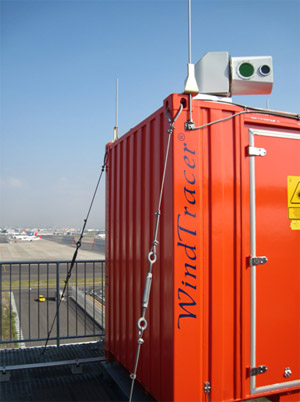
In 1982, the FAA, The National Center for Atmospheric Research (NCAR), and the University of Chicago collaborated to better understand the microburst threat to aviation. Research involved Doppler Radar, anemometers, and sounding systems located in eastern Colorado. During the summer of 1982, approximately 99 microburst events were detected within 10 nautical miles of Denver's Stapleton Airport. This research was identified as “Joint Airport Weather Studies Project (JAWS)” An overview of the JAWS Program can be found in a paper titled “Windshear Hazards to Aviation Operations”, prepared by NCAR, dated July 2012 is available at the following link: (JAWS Overview)
Two high profile accidents, Flight 759, a Boeing 727 attempting to take off from New Orleans in 1982, and Flight 191, a Lockheed L-1011 attempting to land at Dallas-Fort Worth (DFW) in 1985 would punctuate the fact that there was a need to detect and "escape" low level windshear, not just "cope" with the hazard. These accidents would lead to the development and widespread deployment of ground-based and airborne windshear detection equipment.
The National Transportation Safety Board (NTSB) issued 22 findings, primarily regarding the weather conditions at the time of the accident, and flight crew responses to the windshear event.
The NTSB further issued the following probable cause:
“The National Transportation Safety Board determines that the probable cause of this accident was the aircraft’s encounter with adverse winds associated with a very strong thunderstorm located astride the ILS localizer course, which resulted in a high descent rate into the nonfrangible approach light towers. The flight crew’s delayed recognition and correction of the high descent rate were probably associated with their reliance upon visual cues rather than upon flight instrument references. However, the adverse winds might have been too severe for a successful approach and landing even had they relied upon and responded rapidly to the indications of the flight instruments.
Contributing to the accident was the continued use of runway 22L when it should have become evident to both air traffic personnel and the flight crew that a severe weather hazard existed along the approach path.”
The findings, excerpted from the accident report, are available at the following link: (NTSB Findings)
The entire accident report can be found at the following link: (Accident Report).
The NTSB issued 14 recommendations. A number of the recommendations centered on research to gain a better understanding of the hazards associated with thunderstorms and wind shear. This research would lead to the discovery and classification of the "Downburst" and the "Microburst". Further development was advocated for systems to detect and announce wind shear and thunderstorms. This work led directly to deployment of the Low Level Windshear Avoidance System (LLWAS).
These research and development activities ultimately advanced the science of weather forecasting and weather radar; leading to the development of ground based, and airborne, Doppler Radar. These systems would later be mandated into widespread deployment in the wake of Delta Flight 191's accident at Dallas-Fort Worth in 1985.
A copy of the recommendations, excerpted from the accident report are available at the following link: (NTSB Recommendations)
At the time of Eastern Flight 66 there were no specific regulations regarding Wind Shear.
Eastern Air Lines Administrative Bulletins were addressed directly in the NTSB accident report:
“During the year preceding the accident, Eastern issued a number of bulletins on low-level wind shear associated with both thunderstorms and frontal-zone weather. Although the bulletins were informative and contained many suggestions on how to anticipate and detect low-level wind shear, they did not provide specific flying techniques to overcome the effects of low-level wind shear. The bulletins implied that higher approach speeds should be used when shear is anticipated, but cautioned that when runways are wet excessive landing speeds should be avoided because of hydroplaning.”
At the time of the Eastern 66 accident, the prevailing belief was that low-level wind shear could be coped with by using proper flying techniques. However, subsequent aviation-related meteorological research led to the discovery and characterization of previously unknown windshear phenomena - the downburst and microburst. The intensity and short life of these downdrafts posed a grave danger to aviation, particularly in the takeoff and landing phase of flight. The phenomena would be exemplified by several accidents in the decades after the Eastern 66 accident. Highlighted by the Delta Flight 191 accident at Dallas/Fort Worth airport in 1985, the Microburst is now understood to produce a windshear that is significantly hazardous to warrant that it be sensed and avoided.
- Continuation of an approach into significant windshear produced by a series of microbursts
- Significant gaps existed in the ability to gather and disseminate operationally useful hazardous weather updates to flight crew in the John F. Kennedy International Airport terminal area.
- Terminal operations were not able to discern the presence of severe weather on a given approach path and make timely decisions to change flow patterns to the airport.
- Reliance on reports from preceding aircraft to determine the safety/advisability of continuing an approach.
- The intensity and unpredictable nature of the Downburst/Microburst phenomena was not yet understood, so flight crews and air traffic controllers were not armed with specific operational parameters with which to make sound operational decisions. Therefore, the primary indicator as to whether a hazard existed on an instrument approach was the success of other aircraft flying the approach.
- A single wind sensor, stationed at one position on an airport would be adequate to provide takeoff/approach decision making for all runways at the airport.
- Pilots could discern the presence of hazardous weather and be trained to avoid it.
- Low altitude windshear encounters could be successfully dealt with by adding speed to the approach.
- Adequate airplane performance would be available to escape a wind shear encounter, provided proper piloting techniques were used to initiate a go-around.
July 23, 1973, Ozark Airlines flight 809, a Fairchild-Hiller 227B, crashed near St. Louis Airport, killing 38 of the 44 persons aboard. Probable cause was the aircraft's encounter with a downdraft following the captain's decision to initiate and continue an instrument approach into a thunderstorm. Shortly before the crash, the flight crew was informed by the tower controller of a heavy rain shower moving right across the approach end of the runway. The crew acknowledged that they could see the shower but elected to continue the approach. After passing the Outer Marker, the aircraft began to descend below the glide slope until it struck the ground.
December 17, 1973, Iberia flight 933, a McDonnell Douglas DC-10, approaching Boston’s Logan International airport in bad weather (rain, fog, 2 miles visibility) struck approach lights 500 feet short of the threshold and collided with a dyke. The right main gear was sheared off, and the aircraft then skidded and came to a rest 3000 feet from the threshold. The accident caused injuries but no fatalities. The aircraft was written off. Information from the aircraft’s flight data recorder helped investigators establish the presence of windshear. Subsequent study of this accident led to a new understanding and awareness of the windshear hazard. In this accident the pilot did not recognize, and may have been unable to recognize, the increased rate of descent in time to arrest it before the aircraft struck the approach light piers. The increased rate of descent was induced by an encounter with a low-level windshear at a critical point in the landing approach where the pilot was transitioning from automatic flight control under instrument flight conditions to manual flight control with visual references. The pilot's ability to detect and arrest the increased rate of descent was adversely affected by a lack of information as to the existence of the windshear and the marginal visual cues available.
In the wake of Eastern 66, the Low Level Windshear Alert System (LLWAS) was developed and received widespread deployment at 110 high risk airports between 1977 and 1987. This system was designed to provide an in-situ measurement of the presence of a "gust front" or other windshear. However, due to the intensity, compactness, and short-lived nature characteristic of microbursts, the initial system had practical limitations in the ability to detect microbursts and provide timely warning to flight crews once in the terminal area.
The meteorology of the Eastern 66 accident was studied in detail, leading to the identification of the "downburst" phenomenon, which was further studied in several well-funded field studies aimed at pinpointing the specific hazard to aviation. The result was the characterization of the "microburst" which would provide the technical parameters to which Terminal Doppler Weather Radar (TDWR) and Airborne Predictive Windshear alerts would be designed.
Until the occurrence of the Delta Flight 191 Accident in Dallas, Texas in 1985 (also included in this library), and associated research, the downburst/microburst phenomenon was not well understood by the industry. Following the Delta 191 accident, research led to technology advances that led to improvements in windshear detection and avoidance capabilities of airplanes and air traffic control facilities.
Airplane Life Cycle:
- Operational
Accident Threat Categories:
- Windshear
Groupings:
- Loss of Control
- Approach and Landing
Accident Common Themes:
- Flawed Assumptions
Flawed Assumptions
Eastern 66's flight crew assumed they could out-perform the environmental conditions they were facing during this approach. This assumption was reinforced by two aircraft that made successful approaches to the same runway just prior to their approach. What was not known at the time of the Eastern 66 accident was the existence of the "microburst" - a severe, localized, short duration, downdraft which poses a particular hazard to aircraft approaching or departing a terminal area.
August 7, 1975, Continental flight 426
A Boeing 727, attempting to takeoff from Denver’s Stapleton airport runway 35L reached approximately 100 feet altitude then crashed near the departure end of the runway. At the time of the accident, a thunderstorm with associated rainshowers was moving over the northern portion of the airport. The National Transportation Safety Board determined that the probable cause of this accident was the aircraft’s encounter, immediately following takeoff, with severe windshear at an altitude and airspeed that precluded recovery to level flight; the windshear caused the aircraft to descend at a rate which could not be overcome even though the aircraft was flown at or near its maximum lift capability throughout the encounter. The windshear was generated by the outflow from a thunderstorm which was over the airplane’s departure path. The 134 persons aboard the aircraft survived the crash though 15 were severely injured.
June 23, 1976, Allegheny flight 121
A Douglas DC-9, attempting to land at Philadelphia International Airport, Philadelphia, Pennsylvania, crashed on the taxiway approximately 4000 feet beyond the threshold of runway 27 after encountering a windshear and attempting to go-around.
July 9, 1982, Pan Am flight 759
A Boeing 727, attempted to depart the New Orleans International Airport during a severe thunderstorm. The aircraft climbed to approximately 100 feet when it began to descend, striking trees past the end of the runway and crashing into a residential area. All 145 people aboard the aircraft along with 8 people on the ground were killed in the accident. Probable cause was identified as “the airplane’s encounter during the liftoff and initial climb phase of flight with a microburst-induced windshear which imposed a downdraft and a decreasing head wind, the effects of which the pilot would have had difficulty recognizing and reacting to in time for the airplane's descent to be arrested before its impact with trees. Contributing to the accident was the limited capability of current ground based low level windshear detection technology to provide definitive guidance for controllers and pilots for use in avoiding low level windshear encounters.”
May 31, 1984, United flight 663
A Boeing 727, attempting to takeoff at Stapleton International Airport runway 35L struck a localizer antenna 1074 feet beyond the departure end of runway 35L after an encounter with a microburst.
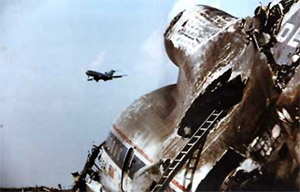
August 2, 1985, Delta Flight 191
A Lockheed L-1011 approaching to land at Dallas/Fort Worth International Airport’s runway 17L encountered a microburst while attempting to pass through a rain shaft underneath a convective storm cell. The aircraft touched down in a field approximately 6,000 feet short of the runway, bounced, struck a car on a highway, struck two water tanks on the airport and broke apart. With the exception of the tail section which broke loose from the rest of the airplane, the impact sequence and resultant fire destroyed the aircraft. Of the 163 persons aboard, 134 passengers and crewmembers were killed at the scene. The driver of the car was also killed, and two passengers died more than 30 days after the accident as a result of their injuries.
This accident again highlighted the inadequacies of the then-current ground-based low-level windshear alert systems (LLWAS) employed at many airports. It also highlighted that crew knowledge of the effects of “microbursts” training was inadequate to combat this threat to aviation safety. Delta Flight 191 became the catalyst in accelerating the development of airborne real-time windshear detection, windshear avoidance philosophy, and the widespread deployment of early warning systems.
See accident module
July 2, 1994, USAir Flight 1016
A Douglas DC-9, crashed after experiencing a thunderstorm induced microburst while attempting to land at Charlotte-Douglas airport killing 37 of the 57 persons aboard. The weather information provided to the flight crew from USAir dispatch indicated that the conditions at Charlotte were similar to those encountered when the crew had departed there approximately 1 hour earlier. The only noted exception was the report of scattered thunderstorms in the area. Approaching Charlotte, the DC-9 flight crew noted visually and on airborne weather radar that rain and cloud buildups had moved into the vicinity of the airport. With visual contact of the runway, the flight crew turned from base to final and followed a Fokker 100 who had reported a smooth ride on their approach. The cloud buildup had evolved into a thunderstorm and the DC-9 entered an area of rainfall and experienced a 20-knot deviation in airspeed on final approach to which the crew reacted by executing a missed approach. The first officer initially rotated the airplane to the proper 15 degrees nose-up attitude during the missed approach. However, the thrust was set below the standard go-around thrust limit, and the pitch attitude was reduced to 5 degrees nose down before the flight crew recognized the dangerous situation. The flight crew failed to establish and maintain the proper airplane attitude and thrust setting necessary to escape the windshear and the airplane struck the ground after transitioning from a headwind of approximately 35 knots, to a tailwind of 26 knots (a change of 61 knots), over a 14 second period.
Technical Related Lessons
Atmospheric microbursts can involve extremely sudden, high intensity downdrafts, such that, when occurring close to the ground, can generate rapid and severe changes in wind direction. Operational safety must be predicated upon early detection and avoidance, as their severity can be such that they will exceed the performance capability of any pilot or airplane. (Threat Category: Windshear)
- At the time of this accident, the possibility of low-level windshear associated with both thunderstorms and frontal-zone weather was understood. Information was available to help flight crews anticipate and detect the presence of low-level windshear. As a precautionary measure, when windshear was anticipated, suggested operating procedures at the time included adding speed margins to normal approach speeds in order to cope with the windshear hazard. It would take a detailed meteorological analysis of this accident to discover the severity and short-lived nature of downbursts and microbursts. It would then take over a decade, including several high profile accidents, for the aviation community to embrace the fact that some low-level windshear phenomena simply could not be coped with using piloting techniques, and must be detected and avoided.
In the event of an inadvertent entry into a severe windshear, an escape maneuver must be adopted promptly and correctly. Flight crews should be trained and equipped to recognize windshear and use all of their aircraft's available performance should the need arise. (Threat Category: Windshear)
- In support of the Eastern 66 accident investigation, piloted simulations were flown with estimated wind models in an effort to assess the influence of pilot responses on aircraft control and performance. The results of these simulations noted that when attempting to execute a go-around in response to a detected windshear, it was common for the pilots to not rotate the aircraft to a pitch attitude which would provide the maximum performance capability of the aircraft. Several pilots noted that the back pressure needed on the control column was significantly more than they had anticipated due to variation in longitudinal trim requirements induced by the rapid loss of airspeed. Additionally, several pilots added less than maximum thrust, due to a tendency to not want to interrupt their instrument scan while attempting to fly away from the ground (though modern engine technology advances have made this less of an issue). It would take over a decade, including several high-profile accidents, for the aviation community to recognize that "proper" piloting techniques often means abandoning an approach well before descending to minimums if low-level windshear conditions are encountered.
Common Theme Related Lesson
Due to the sudden, violent, and highly localized nature of a microburst, a pilot's decision to continue a landing or perform a takeoff should not be predicated on the success of preceding aircraft, regardless of the physical size or performance capability of the aircraft involved. (Common Theme: Flawed Assumptions)
- Eastern Flight 66 was attempting to make their approach through instrument meteorological conditions while the high-density airport was operating at capacity. The flight crew would have been aware that electing to not fly the approach to the active runway would have resulted in a delayed arrival at their gate, or a diversion to an alternate airport. Without knowledge of the severity and short-lived nature of the downburst/microburst phenomena, and with no onboard windshear detection system, the flight crew likely relied heavily on the success of other aircraft attempting to land at JFK.
